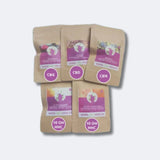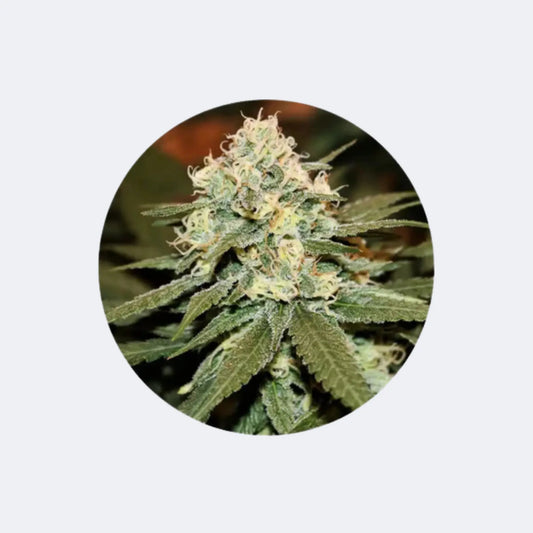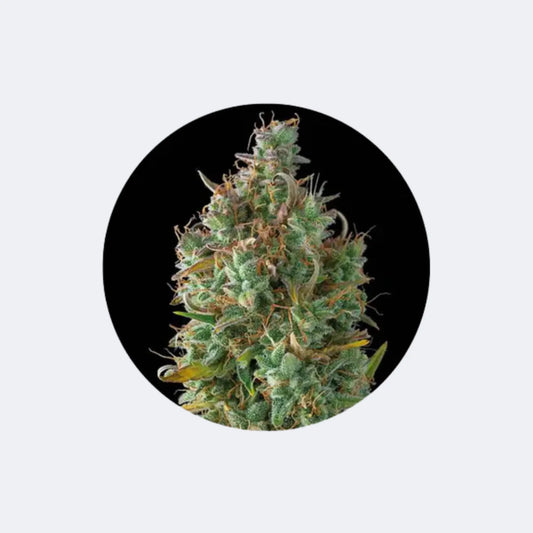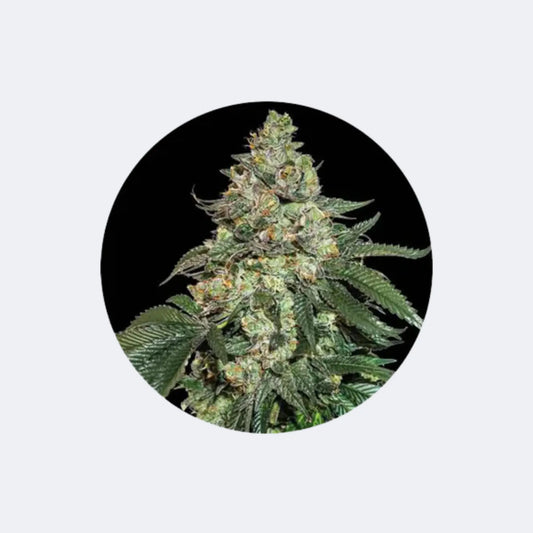
Germinate cannabis seeds
Andreas LeschkeShare blog post
How to germinate cannabis seeds .
"Birth preparation for cannabis"
There are many ways to germinate cannabis seeds , so each of these methods has its own small and large pitfalls that you should consider in order to ultimately decide which germination option to choose.
As basic information, please note that the usual recommended temperature for germination of cannabis seeds, from 22 to 25°C, is only an average value, which can be lower or higher depending on the genetics, so the range, as further results have shown, is actually between 19 and 30°C.
Furthermore, it should be noted that seeds of our beloved and cherished fun flower prefer very high humidity in order to feel comfortable, want to participate in life and germinate.
For this reason alone, I try to create a tropical environment when germinating my beloved cannabis seeds in order to achieve a high and reliable germination rate.
Another important factor is that cannabis seeds are "dark germinators," which means they are sensitive to light. Therefore, seeds should always be placed in a dark place to germinate, as light could otherwise damage them.
Now that we know the basic requirements for successful germination of cannabis seeds, let's look at the different germination methods that are most commonly used:
1. The coconut pellet method:
A very common method is to germinate seeds in so-called coco pellets. The coco pellet is first soaked in a spray bottle with water to create a soft base where an opening can be poked for the seed to be placed. It is then usually sprayed thoroughly again and placed in a miniature greenhouse, shaded with a towel, in a warm location.
However, I would generally advise against this method, even though it can certainly germinate seeds quickly in a miniature greenhouse.
The reason I advise against this is that it's difficult to keep the coco pellets soft enough for the roots to spread. Coco pellets have properties similar to peat, so once they dry out, it's difficult to soften them again to absorb water.
For me, the seeds always germinated using this method, partly because I was able to create a tropical environment with sufficient warmth and humidity using a mini-greenhouse. However, it wasn't uncommon for young seedlings to rot after germination. I suspect this was because the coco pellet didn't retain enough moisture, like good peat-free tomato soil, to allow the plant to absorb enough nutrients for vigorous growth.
2. "Germinate seeds in a small pre-growth pot with soil":
Another method is to plant the seed in a small pot. Personally, I find this method more effective than the coco method. Choosing good soil provides the seed, from which the seedling will sprout, with the necessary nutrients and a soft soil that's easy to keep moist, ensuring the seedling's nutrient supply is maintained.
For this method, simply take a small growing pot that fits inside a mini greenhouse, fill it with good, peat-free tomato soil, and lightly press it down. Then, dig a small hole about 1 cm deep in the center of the soil and place the seed in the hole. Then, carefully cover the hole with some soil and spray the soil with water using a spray bottle to keep it nice and moist.
Please make sure you use good, peat-free tomato soil, which costs around €10 for a 40-litre bag, but under no circumstances should you use cheap soil from discount stores or DIY stores, as this is often contaminated with pests such as fungus gnats.
If fungus gnat larvae develop in the nutrient soil, which is very common in cheap soil, they will attack the roots of the seedling and destroy it, so that the seedling has no chance of developing and will quickly die.
I will write a separate blog post on the topic of "Common problems with grow projects," where I will also delve deeper into the topic of "Fighting pests with beneficial organisms."
However, those who choose this method and use a mini greenhouse to ensure the necessary warm and humid temperatures will achieve germination rates just as high as with the coco pellet method, but with the advantage that the soil does not dry out as quickly and the plant is supplied with the necessary nutrients right from the start.
However, even with this method, please remember to choose a warm location (preferably next to a heater) and to darken the greenhouse with a towel so that the seeds have a nice, dark, moist and warm environment.
In my experience, the germination time is between 3 - 6 days, depending on the genetics.
However, what you should keep in mind with this variant, as well as with the coco pellet variant, is that you have to repot the young plant from the nursery pot into the final pot so that it can develop into a mature and strong cannabis plant.
Repotting always carries the risk of damaging fine root hairs and stressing the plant, so it can take up to 5 days for it to recover and continue developing.
Therefore, for personal reasons, I reject these variants and generally advise against them with automatic seeds, as the lifespan of 8-12 weeks is already extremely short, so that any stress that can be avoided should be avoided in order to prevent growth failures and achieve a successful yield.
3. The water glass variant:
The third and most well-known way to encourage seeds to germinate is the "glass of water method." This involves filling a glass with approximately 25°C water and placing the seeds in the water. Then, cover the glass with a cloth and place it in a warm place (e.g., next to a heater).
Please note that if you place the jar on a windowsill in spring or summer, as it receives enough warmth during the day, you should also monitor the temperature in the evening and at night to ensure it doesn't drop below 20°C and cool down. Otherwise, your seeds might quickly resent you and refuse to germinate.
The temperature should be constant at 20 to 27°C to achieve successful germination.
However, I advise against putting more than one seed in each jar when using this method, as after germination the roots of the seeds can quickly become entangled and then have to be separated, which carries the risk of damaging the roots.
Germination with this method usually begins after 24 hours of soaking the seeds. However, this method shouldn't take longer than 6 days, as it's important that the seeds don't absorb too much water to avoid damage. Therefore, please remember to shade the glass of water with a towel and keep it consistently warm, otherwise germination will be delayed or, in the worst case, even fail completely.
Please also check regularly to see when the seed has germinated. As soon as the stem root has grown out and the seed cap has been removed, the seedling should be planted in soil as quickly as possible so that it can absorb its nutrients and doesn't start to rot in the glass of water.
4. The kitchen paper method:
The fourth option that I would like to introduce to you is the one that I personally prefer to achieve a guaranteed germination rate, so that I can speak of a 100% germination rate here, provided the seed is intact and not too old or has been stored incorrectly, is the method with kitchen paper and a small plastic box (e.g. Tupperware).
For this version, you first place a thick layer of kitchen paper, such as Zewa, in a small plastic container, so that you have four layers. I always fold a piece of kitchen paper twice to create four layers.
The paper towel is then sprayed with water from a spray bottle until it's nice and wet. Not so much that water floats in the box, but enough to make it really wet and soft.
Now place the seed in the center of the paper towel and place another four-ply paper towel on top. This is then thoroughly soaked with water from a spray bottle and then gently pressed down. Don't press too hard, just enough to ensure it sits evenly on the seed.
Once this is done, close the plastic box with the lid and place it directly next to a warm heater and darken the box with a towel.
This creates the same greenhouse effect that you can achieve with a miniature greenhouse, creating a tropical environment with sufficient humidity and warmth for the seeds to feel comfortable and germinate happily.
The germination rate with this method is 2-3 days.
It's very rare that it took me 4 days for me to be able to say that it was special cannabis genetics that popped up with a delay.
After germination, the young seedling should, of course, be planted in soil as soon as possible to allow it to develop, and should be placed directly into its final pot. This way, as with the water glass method, you avoid unnecessary growth losses due to stress and no longer have to worry about repotting.
I will explain how to insert it into the muffler and what you need to take into account in my next blog post.
Finally, I would like to briefly mention that there is a similar method to the kitchen paper variant, in which you use cotton wool instead of kitchen paper.
The germination rate is just as high, but I still advise against it. After germination, the roots usually begin to bore through the cotton wool, and you then have the problem of removing the cotton wool residue from the seedling, which can quickly damage the roots.
Therefore, I won't go into this option in detail, as I would advise against it. Instead, use kitchen paper; it's less likely that the roots will get caught in it, and if it does happen, it's much easier to remove the seedling from the damp kitchen paper without causing any damage than with the cotton wool option.
We thank the author Jorge Rieger for this blog post on germinating cannabis seeds. Feel free to follow him on his Facebook account. --> Click here







